|
News and Events 2008
NOAA Transfers Decommissioned NOAA Ship Rude to the Environmental Protection Agency
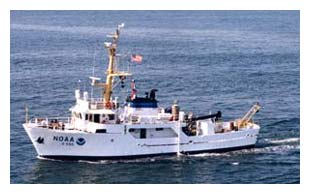 On July 7, 2008, the Commanding Officer of the Marine Operations Center-Atlantic signed the documentation transferring the decommissioned ship Rude to the EPA. Congress was notified prior to the transfer. The ship will remain alongside the Norfolk pier until mid-August while EPA conducts the repairs, modifications, and familiarization needed before sailing the ship to her new home at the EPA National Health and Environmental Effects Research Laboratory in Duluth, MN. Rude’s replacement ship, Ferdinand R. Hassler, is currently under construction in Moss Point, Mississippi. On July 7, 2008, the Commanding Officer of the Marine Operations Center-Atlantic signed the documentation transferring the decommissioned ship Rude to the EPA. Congress was notified prior to the transfer. The ship will remain alongside the Norfolk pier until mid-August while EPA conducts the repairs, modifications, and familiarization needed before sailing the ship to her new home at the EPA National Health and Environmental Effects Research Laboratory in Duluth, MN. Rude’s replacement ship, Ferdinand R. Hassler, is currently under construction in Moss Point, Mississippi.
Oscar Dyson Recognized for Record-Breaking Marine Weather Data Contributions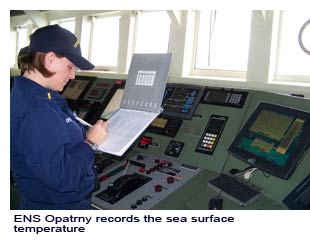
While sailing the waters of Alaska, NOAA ship Oscar Dyson-–like other ships in the fleet—adds value to her mission by participating in the National Weather Service’s Voluntary Ship Observing (VOS) program. Oscar Dyson recorded and distributed an all-time NOAA fleet record of 1,897 valuable marine weather observations in 2007, aiding in the weather service’s timely and reliable services to mariners. As a result, the NWS has honored Oscar Dyson with a USA 2007 Voluntary Observing Ship award for excelling in her contributions to the VOS program.
But those aboard the ship aren’t satisfied with breaking the NOAA record. They want Oscar Dyson to be the top VOS contributor in the world. Oscar Dyson has begun ramping up its observations by supplementing manual observations with automated ones. Significantly increasing the number of observations will provide an invaluable service to others transiting the often stormy waters of Alaska as well as add to the treasure trove of data supporting global climate research. Read more...
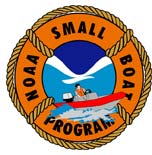 NOAA Issues New Small Boat Standards and Procedures NOAA Issues New Small Boat Standards and Procedures
NOAA’s Small Boat Program, which is managed by OMAO has achieved a significant accomplishment with the official release of the new Small Boat Standards and Procedures Manual and NOAA Administrative Order 209-125, which replaces NAO 217-103. These new policies, standards, and procedures will enhance the safe operation of all NOAA small boats (i.e. boats less than 300 gross tons) and encourage a corporate culture that values the skilled small boat operator, encourages the distribution of information, seeks a quality approach, shares commitment, and seeks to manage operational risk.
The manual will be maintained by the Small Boat Safety Board, which has representation from organizational components across NOAA. Presently NOAA owns or operates 417 small boats ranging from kayaks to 85-foot research vessels. These boats are operated by nearly 800 small boat operators in diverse regions such as American Samoa, Antarctica, and Long Island Sound. For complete details, please visit the NOAA Small Boat Program Web site to view the NAO, manual, and the many other links and tools for NOAA's small boat community.
NOAA Ship Rainier Gets New Survey Launches
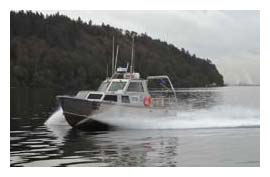 NOAA recently took delivery of a new survey launch--the second of a pair of identical 28 ft. vessels built by All American Marine of Bellingham, WA. The new aluminum-hulled boats replace survey launches that have seen over 30 years of service in conducting hydrographic survey operations along the Alaskan and West coasts. The boats are carried by NOAA ship Rainier. The design of the new launches is based on an evolution of the existing hull form and was updated by Jensen Maritime Architects, the firm that designed the NOAA 28-ft. survey launch in 1975. The multi-mission designed boats are equipped with a state-of-the-art hydrographic surveying suite. Typical survey speeds are approximately 8 knots. NOAA installed and integrated the survey systems and has put both boats into operational use. NOAA recently took delivery of a new survey launch--the second of a pair of identical 28 ft. vessels built by All American Marine of Bellingham, WA. The new aluminum-hulled boats replace survey launches that have seen over 30 years of service in conducting hydrographic survey operations along the Alaskan and West coasts. The boats are carried by NOAA ship Rainier. The design of the new launches is based on an evolution of the existing hull form and was updated by Jensen Maritime Architects, the firm that designed the NOAA 28-ft. survey launch in 1975. The multi-mission designed boats are equipped with a state-of-the-art hydrographic surveying suite. Typical survey speeds are approximately 8 knots. NOAA installed and integrated the survey systems and has put both boats into operational use.
NOAA expects that the speed and reliability of these new boats will improve overall survey efficiency, as well as contribute to improved safety levels. NOAA intends to replace the aging fleet of survey launches with six to eight additional launches purchased over the next four years.
NOAA Aircraft to Probe Arctic Pollution
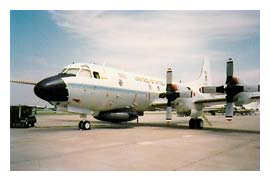 Scientists aboard NOAA's WP-3 Lockheed Orion aircraft N43RF will be flying through springtime Arctic pollution to find out why the region is warming — and summertime sea ice is melting — faster than predicted. Some 35 NOAA researchers are gathering with government and university colleagues in Fairbanks, Alaska, to conduct the study through April 23. Scientists aboard NOAA's WP-3 Lockheed Orion aircraft N43RF will be flying through springtime Arctic pollution to find out why the region is warming — and summertime sea ice is melting — faster than predicted. Some 35 NOAA researchers are gathering with government and university colleagues in Fairbanks, Alaska, to conduct the study through April 23.
Called ARCPAC (Aerosol, Radiation, and Cloud Processes affecting Arctic Climate Change), the project is a NOAA contribution to International Polar Year 2008. The experiment will be coordinated with the agency’s long-term climate monitoring station at Barrow, Alaska, and with simultaneous projects conducted by NASA and the Department of Energy.
Scientists aboard the aircraft will use nearly 30 airborne sensors to answer questions about airborne particles, altered clouds, low-altitude ozone, and soot deposited on snow. Read the full story.
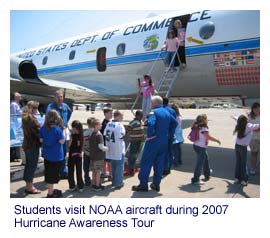 NOAA
Hurricane Hunter Aircraft to Embark on Gulf Coast Tour NOAA
Hurricane Hunter Aircraft to Embark on Gulf Coast Tour
NOAA hurricane experts will travel aboard a NOAA WP-3 Orion turboprop Hurricane Hunter aircraft in a five-day, five-city tour of the Gulf Coast beginning April 14 to raise awareness of the hurricanes that can and have threatened the region.
The aircraft will visit Corpus Christi, Texas, Galveston, Texas, New Orleans, Louisiana., Apalachicola, Florida, and Ft. Myers, Florida. The public and media are invited to tour the aircraft and speak with the delegation.
The hurricane awareness tour has been conducted for more than 25 years, alternating between the Gulf and Atlantic coasts, and is followed by NOAA’s hurricane hazard education campaign during national Hurricane Preparedness Week, May 25 to 31. The Atlantic hurricane season begins June 1. Read the full story.
 NOAA Ship Rude is Retired NOAA Ship Rude is Retired
The Smallest NOAA Ship Made Big Contributions -- The 90-ft. NOAA ship Rude (pronounced “Rudy”), best known for its round-the-clock efforts to find the wreckage from TWA flight 800 in July 1996 and John F. Kennedy Jr.’s aircraft in July 1999, was decommissioned at its home port at NOAA’s Marine Operations Center-Atlantic in Norfolk, Va. on March 25 after 41 years of service.
Former commanding officers and crew, including the first commanding officer, CAPT Donald Florwick, NOAA (ret.), and first Executive Officer CDR Karl Kieninger, Jr., NOAA (ret.) gathered for an emotional farewell to the ship. In keeping with tradition, presentation of the ship’s commissioning pennant was made to the ship's last commanding officer, LCDR Rick Brennan, and of the ship’s National ensign to Chief Boatswain Gordon Pringle as the longest-serving (14 years) crew member. The ship’s sign board was presented to Gilbert Rude’s granddaughter, Mrs. Julia Thomas, who was Rude’s sponsor.
The ship’s operational area was primarily along the U.S. Atlantic coast in support of NOAA’s Office of Coast Survey, which is responsible for charting the nation's waterways in support of safe, efficient, and environmentally sound marine transportation. Read the NOAA Press Release for the full story.
New Video about NOAA
A "One NOAA" video produced by NOAA's National Ocean Service's video studio (Ocean Media) in Seattle, shows footage of our ships, aircraft, and diving operations. Take a look to see some of the work we do for NOAA. (Quicktime movie - 8.24MB.
 |
CB William Sliney passes a heaving line to the crew of the disabled fishing vessel.
-- Photo by SST Kathy Hough |
Oscar Dyson Lends Support Beyond Usual Alaska Operations
NOAA Ship Oscar Dyson briefly broke away from fishery research in March to conduct both simulated and real emergency operations under two very different scenarios.
On the evening of March 26, OSCAR DYSON responded to a call for assistance by a disabled fishing vessel drifting toward rocks near Afognak Island in Shelikof Strait. Oscar Dyson towed the boat to a rendezvous with a second fishing vessel at Cape Douglas. The other fishing vessel had been dispatched from Homer, Alaska, earlier to tow the disabled vessel home, but was unable to arrive in time to prevent it from running aground. Fortunately, Oscar Dyson was in the area to intervene. Six hours later, the disabled vessel was successfully transferred.
Oscar Dyson served as a training platform to conduct medical evacuation drills for the United States Coast Guard (USCG) on March 13, 2008. The ship worked with two USCG rescue helicopters based at USCG Air Station Kodiak. Each of the two USCG aircraft and aircrew were provided with one hour of ship time while underway in Chiniak Bay. The drills are essential to conduct in order to assure that the ship’s outlined procedures would work in an emergency situation. Read the full story
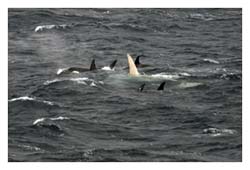 |
Photo credit: H. Fearnbach,
NMML, NMFS permit 782-1719 |
Rare White Killer Whale Sighted by NOAA Scientists Aboard NOAA Ship Oscar Dyson
With icy decks and a windy forecast, the NOAA ship Oscar Dyson departed Dutch Harbor, Alaska, on February 17, 2008, and headed west into the Bering Sea on a pollock acoustic survey.
The primary purpose of the cruise was to determine pollock distributions near Stellar sea lion haul-outs. Winter is a critical time for survival of the sea lions, and pollock is one of their primary food sources. Winter is a difficult time to conduct surveys in the Aleutian Islands due to stormy weather in the Bering Sea.
During this cruise, pods of killer whales were observed, including one pod with an unusual member. Unlike its dark black companions, there was one whale that did not look like the others--it was white! Read the full story and the NOAA press release for further details.
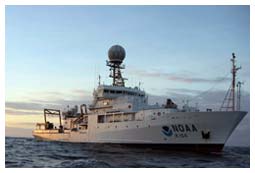 NOAA Ship Ronald H. Brown Heads Towards Antarctica for Southern Ocean Gas Exchange Experiment NOAA Ship Ronald H. Brown Heads Towards Antarctica for Southern Ocean Gas Exchange Experiment
In late February, more than 30 scientists embarked on a research cruise to the Southern Ocean, which surrounds Antarctica, where they will be battling nature’s elements to study how gases important to climate change move between the atmosphere and the ocean under high winds and seas.
The Southern Ocean Gas Exchange Experiment, a six-week cruise aboard the NOAA ship Ronald H. Brown, is co-sponsored by NASA, the National Oceanic and Atmospheric Administration (NOAA), and the National Science Foundation. Scientists will study the movement of gases such as carbon dioxide in an effort to improve the accuracy of climate models and predictions during the cruise, which departed Feb. 28 from Punta Arenas, Chile. Read the full NOAA News story... You can read the cruise blogs for updates on what is happening -- The Mess mentions the BROWN's Chief Steward, Richard Whitehead.
 NOAA WP-3D Orion Supports Winter Storm Reconnaissance Mission NOAA WP-3D Orion Supports Winter Storm Reconnaissance Mission
NOAA's WP-3D Orion N42RF is providing support for Winter Storm Reconnaissance 2008 (WSR-08) February 1—March 15. The basic objective of WSR-08 is to obtain vertical profiles of key atmospheric parameters utilizing GPS dropsondes and transmission of these data to the National Centers for Environmental Prediction. The ultimate goal is to provide improvements to winter storm forecasts over the North Pacific Ocean. Read the NOAA News story for more information. You can also see a video of the flight made by KATU-TV in Portland, Oregon, (click on the video link to watch the movie)
 NOAA Divers Assist With Calibrating Net Sensors NOAA Divers Assist With Calibrating Net Sensors
On January 10 and 23, Albatross IV divers Master Steve Wagner, 1st Officer Donn Pratt, ENS Chris Skapin and ENS Chad Meckley assisted Biological Scientific Technicians Sean Lucey and Jonathan Duquette, from the Northeast Fisheries Science Center, in calibrating Henry B. Bigelow's new four seam trawl net sensors. The science team endured sub-freezing air temperatures while the dive team endured 35 degree water temperatures to conduct the sensor calibrations. These efforts continue so Albatross IV can pass the torch to Henry B. Bigelow, ensuring the continuation of the NE Fisheries Bottom Trawl Survey. This survey has been conducted since 1962, making it the longest continuous fisheries survey on record. The survey’s dataset allows the continued viability and management of the nation’s Northeast fisheries.
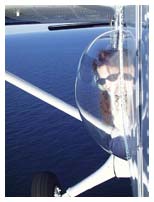 NOAA Aircraft Conducts Southeast Right Whale Survey NOAA Aircraft Conducts Southeast Right Whale Survey
NOAA's Twin Otter aircraft, N46, began a four-month Southeast Right Whale Survey project on December 1, and expects to fly an average of 70-80 hours per month. The primary purpose of the survey is to provide real-time sighting information to commercial shipping interests in an effort to reduce collisions between ships and Northern Right Whales. Additional project efforts include animal identification through photography, and aerial support with radio telemetry for entangled whale rescue efforts.
|


 NOAA Ship Ronald H. Brown Heads Towards Antarctica for Southern Ocean Gas Exchange Experiment
NOAA Ship Ronald H. Brown Heads Towards Antarctica for Southern Ocean Gas Exchange Experiment NOAA WP-3D Orion Supports Winter Storm Reconnaissance Mission
NOAA WP-3D Orion Supports Winter Storm Reconnaissance Mission  NOAA Divers Assist With Calibrating Net Sensors
NOAA Divers Assist With Calibrating Net Sensors NOAA Aircraft Conducts Southeast Right Whale Survey
NOAA Aircraft Conducts Southeast Right Whale Survey Privacy
Policy | Disclaimer | FOIA | NOAA Information Quality
Privacy
Policy | Disclaimer | FOIA | NOAA Information Quality